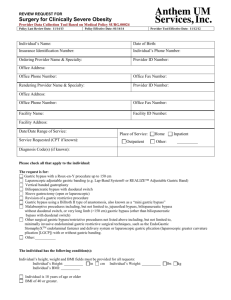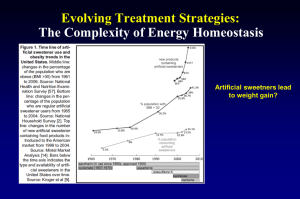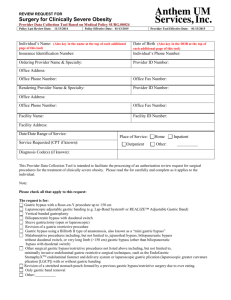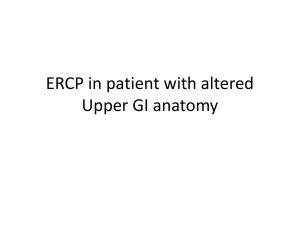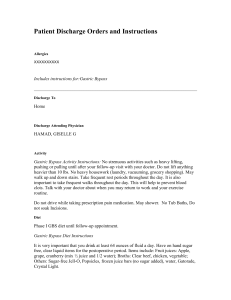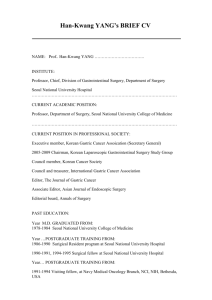Hedonic hunger is increased in severely obese patients and is... after gastric bypass surgery Original Research Communications 1–3
advertisement
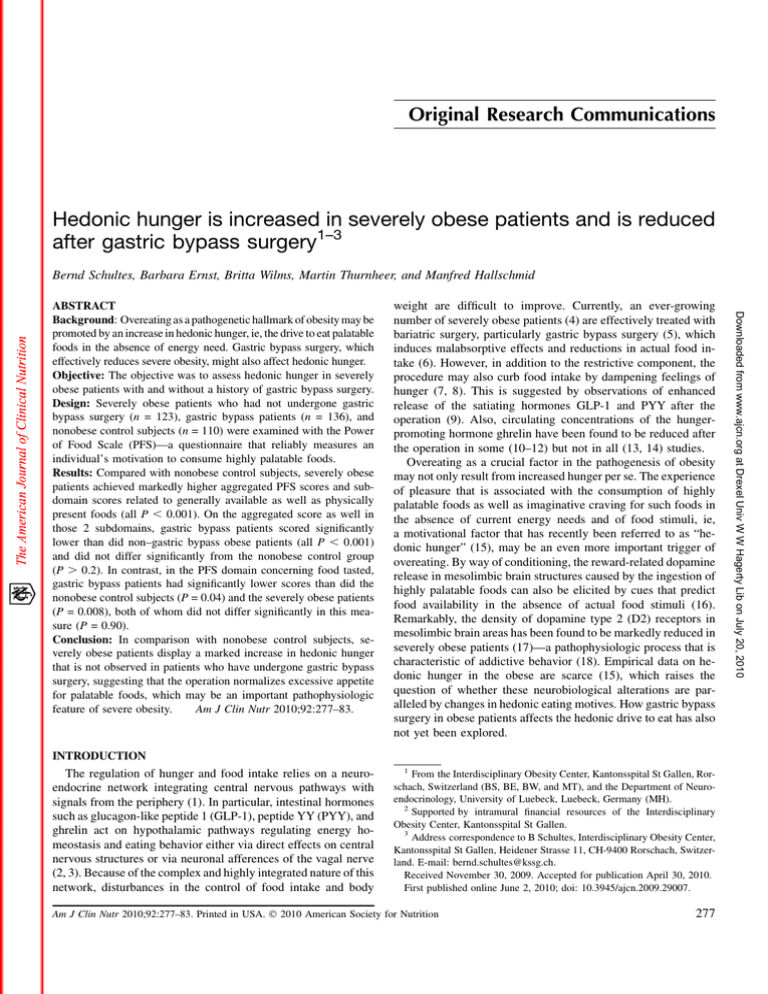
Original Research Communications
Hedonic hunger is increased in severely obese patients and is reduced
after gastric bypass surgery1–3
Bernd Schultes, Barbara Ernst, Britta Wilms, Martin Thurnheer, and Manfred Hallschmid
weight are difficult to improve. Currently, an ever-growing
number of severely obese patients (4) are effectively treated with
bariatric surgery, particularly gastric bypass surgery (5), which
induces malabsorptive effects and reductions in actual food intake (6). However, in addition to the restrictive component, the
procedure may also curb food intake by dampening feelings of
hunger (7, 8). This is suggested by observations of enhanced
release of the satiating hormones GLP-1 and PYY after the
operation (9). Also, circulating concentrations of the hungerpromoting hormone ghrelin have been found to be reduced after
the operation in some (10–12) but not in all (13, 14) studies.
Overeating as a crucial factor in the pathogenesis of obesity
may not only result from increased hunger per se. The experience
of pleasure that is associated with the consumption of highly
palatable foods as well as imaginative craving for such foods in
the absence of current energy needs and of food stimuli, ie,
a motivational factor that has recently been referred to as “hedonic hunger” (15), may be an even more important trigger of
overeating. By way of conditioning, the reward-related dopamine
release in mesolimbic brain structures caused by the ingestion of
highly palatable foods can also be elicited by cues that predict
food availability in the absence of actual food stimuli (16).
Remarkably, the density of dopamine type 2 (D2) receptors in
mesolimbic brain areas has been found to be markedly reduced in
severely obese patients (17)—a pathophysiologic process that is
characteristic of addictive behavior (18). Empirical data on hedonic hunger in the obese are scarce (15), which raises the
question of whether these neurobiological alterations are paralleled by changes in hedonic eating motives. How gastric bypass
surgery in obese patients affects the hedonic drive to eat has also
not yet been explored.
INTRODUCTION
The regulation of hunger and food intake relies on a neuroendocrine network integrating central nervous pathways with
signals from the periphery (1). In particular, intestinal hormones
such as glucagon-like peptide 1 (GLP-1), peptide YY (PYY), and
ghrelin act on hypothalamic pathways regulating energy homeostasis and eating behavior either via direct effects on central
nervous structures or via neuronal afferences of the vagal nerve
(2, 3). Because of the complex and highly integrated nature of this
network, disturbances in the control of food intake and body
1
From the Interdisciplinary Obesity Center, Kantonsspital St Gallen, Rorschach, Switzerland (BS, BE, BW, and MT), and the Department of Neuroendocrinology, University of Luebeck, Luebeck, Germany (MH).
2
Supported by intramural financial resources of the Interdisciplinary
Obesity Center, Kantonsspital St Gallen.
3
Address correspondence to B Schultes, Interdisciplinary Obesity Center,
Kantonsspital St Gallen, Heidener Strasse 11, CH-9400 Rorschach, Switzerland. E-mail: bernd.schultes@kssg.ch.
Received November 30, 2009. Accepted for publication April 30, 2010.
First published online June 2, 2010; doi: 10.3945/ajcn.2009.29007.
Am J Clin Nutr 2010;92:277–83. Printed in USA. Ó 2010 American Society for Nutrition
277
Downloaded from www.ajcn.org at Drexel Univ W W Hagerty Lib on July 20, 2010
ABSTRACT
Background: Overeating as a pathogenetic hallmark of obesity may be
promoted by an increase in hedonic hunger, ie, the drive to eat palatable
foods in the absence of energy need. Gastric bypass surgery, which
effectively reduces severe obesity, might also affect hedonic hunger.
Objective: The objective was to assess hedonic hunger in severely
obese patients with and without a history of gastric bypass surgery.
Design: Severely obese patients who had not undergone gastric
bypass surgery (n = 123), gastric bypass patients (n = 136), and
nonobese control subjects (n = 110) were examined with the Power
of Food Scale (PFS)—a questionnaire that reliably measures an
individual’s motivation to consume highly palatable foods.
Results: Compared with nonobese control subjects, severely obese
patients achieved markedly higher aggregated PFS scores and subdomain scores related to generally available as well as physically
present foods (all P , 0.001). On the aggregated score as well in
those 2 subdomains, gastric bypass patients scored significantly
lower than did non–gastric bypass obese patients (all P , 0.001)
and did not differ significantly from the nonobese control group
(P . 0.2). In contrast, in the PFS domain concerning food tasted,
gastric bypass patients had significantly lower scores than did the
nonobese control subjects (P = 0.04) and the severely obese patients
(P = 0.008), both of whom did not differ significantly in this measure (P = 0.90).
Conclusion: In comparison with nonobese control subjects, severely obese patients display a marked increase in hedonic hunger
that is not observed in patients who have undergone gastric bypass
surgery, suggesting that the operation normalizes excessive appetite
for palatable foods, which may be an important pathophysiologic
feature of severe obesity.
Am J Clin Nutr 2010;92:277–83.
278
SCHULTES ET AL
Reliable assessments of hedonic hunger can be achieved by
means of the Power of Food Scale (PFS), a recently developed and
validated questionnaire that measures an individual’s hedonic
appetite for highly palatable foods but not the actual consumption
of such foods (19, 20). Using this measure, we tested the hypothesis that severely obese patients, in comparison with nonobese
subjects, have an increased level of hedonic hunger. We also
hypothesized that hedonic hunger is reduced in severely obese
patients who have undergone gastric bypass surgery.
SUBJECTS AND METHODS
Gastric bypass procedures
Of the 136 gastric bypass patients, 33 had undergone a standard proximal gastric bypass operation, whereas the remaining
103 patients had undergone a distal gastric bypass operation. In
both the proximal and distal gastric bypass procedure, the largest
part of the stomach was transected, thereby creating a small
gastric pouch of 20 mL, which was anastomized to the proximal
jejunum. The diameter of this pouch-jejunal anastomosis was
standardized to 10 mm. In the proximal gastric bypass procedure,
the biliopancreatic limb (duodenum and upper part of the
proximal jejunum) was side-to-side anatomized to the jejunum
150 cm distal from the pouch-jejunal anastomosis, thereby
creating a Roux-en-Y or alimentary limb. In the distal gastric
bypass procedure, the biliopancreatic limb was side-to-side
anatomized to the ileum 60–100 cm proximal from the Bauhin’s
valve, thereby establishing a rather short common channel. The
length to the biliopancreatic limb, as measured from the ligament
of Treitz, was ’60 cm in the proximal and 60–100 cm in the
distal gastric bypass procedure. Thus, our distal gastric bypass,
in contrast with traditional biliopancreatic diversion procedures,
holds a very long alimentary limb. The main difference between
the 2 gastric bypass procedures is that the distal version induces
stronger malabsorption, particularly of nutritional fats, whereas
the restrictive component of both procedures is comparable.
Body weight
Body height and weight were measured in all subjects while
they were wearing light clothes but no shoes. Percentage weight
loss was calculated as {[preoperative weight (kg) – current
weight]/[preoperative weight]} · 100, percentage excess weight
loss (%EWL) as {[preoperative weight – current weight]/[preoperative weight – height (cm) + 100]} · 100, and percentage
Power of Food Scale
All subjects completed the German version of the PFS generously provided to us by the developers of the questionnaire
(Michael Lowe, Department of Psychology, Drexel University,
Philadelphia, PA) during a visit at our ICO. The PFS was
designed to measure appetite for rather than consumption of
palatable foods and thus does not include any items describing
actual food consumption. It comprises 15 items reflecting the
responsiveness to the food environment grouped into 3 domains
according to food proximity: 1) food readily available in the
environment but not physically present (“food available”), 2)
food present but not tasted (“food present”), and 3) food when
first tasted but not consumed (“food tasted”). Examples of the 3
domains are, respectively, as follows: “I find myself thinking
about food even when I’m not physically hungry”; “If I see or
smell a food I like, I get a powerful urge to have some”; and
“When I eat delicious food I focus a lot on how good it tastes.”
For each item, subjects had to score their reactions on a 5-level
scale: 1 = I don’t agree at all, 2 = I agree a little, 3 = I agree
somewhat, 4 = I agree, and 5 = I strongly agree. Thus, the scores
on each subdomain indicate hedonic hunger motivation at different levels of food availability, ie, ranging from implicitly
knowing that food is generally available to the first tasting of
food, but excluding actual food consumption. The mean of the
items comprising each of the 3 domain scores was calculated to
obtain an aggregated score. Although correlations between the 3
domains have been found to be generally high (all r . 0.77),
thus supporting the use of an aggregated domain score, the 3domain model has been found to be superior to the one domain
model (19). The PFS displays high reliability, with corrected
item-total correlation coefficients ranging from 0.50 to 0.73.
Chronbach’s a is 0.91, and the 4-mo test-retest reliability coefficient is r = 0.77. Translation of the PFS into German was
performed by native speakers of German fluent in English
(PharmaQuest Ltd, Banbury, Oxon, United Kingdom) and included linguistic validation by 2 forward and 2 back translations,
review by the creators, and pilot testing in 5 lay people.
Structured interview in gastric bypass patients
In a subsample of 58 gastric bypass patients, we performed
a structured clinical interview focusing on eating-related symptoms during a regular follow-up outpatient visit. In particular,
patients rated their hunger/appetite as a trait on a 5-point scale
(from 0 to 4). Postprandial pain and feelings of early fullness after
starting to eat were assessed and categorized as “never,” “sometimes,” or “always.” Vomiting, symptoms of “early dumping,”
such as crampy abdominal pain, bloating, and diarrhea as well as
postprandial hypoglycemia-related symptoms (eg, sweating,
shivering, and hunger) as indicators of “late dumping” were also
assessed and categorized as “never,” “seldom,” “sometimes,”
“frequently,” or “always occurring.”
Statistical analyses
Data were analyzed by using SPSS 12.0 for Windows (SPSS
Inc, Chicago, IL). Unless otherwise indicated, data are reported
Downloaded from www.ajcn.org at Drexel Univ W W Hagerty Lib on July 20, 2010
Three groups of subjects participated in the study: 110 nonobese control subjects [body mass index (BMI; in kg/m2) of
18–27] recruited from the local community, 123 severely obese
subjects (BMI . 35) who attended our Interdisciplinary Obesity
Center (IOC) for evaluation for bariatric surgery, and 136
patients who had undergone gastric bypass surgery (for details,
see below) 1 y before participation and were taking part in
a structured IOC follow-up program. Subjects taking drugs
known to strongly affect eating behavior, such as psychotropic
drugs, were excluded from the study. Written informed consent
was obtained from all subjects, and the study protocol
was approved by the cantonal ethic committee of St Gallen
(Switzerland). Data were collected between September 2007 and
September 2009.
excess BMI loss (%EBL) was calculated as [(preoperative BMI
– current BMI)/(preoperative BMI – 25)] · 100 (21).
HEDONIC HUNGER AFTER GASTRIC BYPASS SURGERY
TABLE 1
Characteristics of the subjects
Nonobese
subjects
(n = 110)
Obese
patients
(n = 123)
Gastric bypass
patients
(n = 136)
Preoperative BMI (kg/m2)
89/21
42.1 6 10.6
(21–69)1
22.4 6 2.1
(18.4–26.9)
—
96/27
39.9 6 12.0
(19–67)
45.1 6 6.32
(35.4–66.6)
—
Time since operation (mo)
—
—
101/35
41.4 6 10.6
(20–64)
29.5 6 4.72,3
(19.7–42.1)
47.0 6 5.7
(37.0–67.0)
22.5 6 17.2
(12–132)
Sex (female/male)
Age (y)
Current BMI (kg/m2)
1
2
3
Mean 6 SD; range in parentheses (all such values).
Significantly different from nonobese, P , 0.001 (Tukey’s test).
Significantly different from obese, P , 0.001 (Tukey’s test).
RESULTS
Characteristics of subjects
Characteristics of the subjects are presented in Table 1. By
selection, the obese subjects had a higher BMI than did the
nonobese participants and the gastric bypass patients (P , 0.001
for both comparisons). As a result of surgery, the gastric bypass
patients had lost an average of 48.2 6 14.1 kg (ie, 37.1 6 7.8%
of their initial body weight), corresponding to an average BMI
reduction of 17.5 6 4.7, but still had a higher BMI at the time of
participation than did the nonobese control subjects (29.5 6 4.7
compared with 22.4 6 2.1; P , 0.001). Their mean preoperative
BMI had been higher than that of the current obese group
(47.0 6 5.7 compared with 45.1 6 6.3; P = 0.013). Sex and age
did not differ significantly between groups (P = 0.48 and P =
0.47, respectively).
Group differences in PFS scores
Marked differences between the 3 study groups in all domains
as well as in the aggregated domain score were indicated by
analysis of variance models comprising all groups (all P ,
0.006). Obese subjects had a markedly higher aggregated PFS
domain score than did the nonobese patients (2.8 6 0.9 compared with 2.3 6 0.7; P , 0.001, Figure 1). The gastric bypass
patients had a significantly lower aggregated score (2.2 6 0.7)
than did the non–gastric bypass obese patients (P , 0.001) and
did not differ from the nonobese control subjects (P = 0.40).
Separate analyses of the domain scores “food available” and
“food present” showed a similar pattern, ie, obese patients had
significantly higher scores than did the nonobese group (2.6 6
1.0 compared with 1.9 6 0.8 and 3.0 6 1.0 compared with
2.3 6 0.9, respectively; both P , 0.001) and the gastric bypass
group (2.0 6 0.7 and 2.1 6 0.9; both P , 0.001). Compared
with the nonobese control group, gastric bypass patients had
comparable values on the “food available” (P = 0.80) and the
FIGURE 1. Mean (6SD) aggregated Power of Food Scale (PFS) score and mean (6SD) scores of the PFS subdomains “food available” (regarding food
readily available in the environment but not physically present), “food present” (regarding food present but not tasted), and “food tasted” (regarding food when
first tasted but not consumed) in 110 nonobese control subjects, 123 severely obese patients, and 136 gastric bypass patients. *,**,***Univariate ANOVA:
*P , 0.05, **P , 0.01, ***P , 0.001.
Downloaded from www.ajcn.org at Drexel Univ W W Hagerty Lib on July 20, 2010
as means 6 SDs. Differences across groups were assessed with
univariate analysis of variance for continuous variables or
with chi-square tests for discrete variables. For pairwise comparisons post hoc Tukey tests and chi-square tests were used as
appropriate. Associations between PFS scores and the characteristics of subjects were evaluated with Pearson’s correlation
coefficients and partial correlation analyses. A P value ,0.05
was considered significant.
279
280
SCHULTES ET AL
“food present” domain (P = 0.20). The “food tasted” score did
not differ between obese and nonobese subjects (3.0 6 1.0 and
2.9 6 0.9; P = 0.90), but was lower in the gastric bypass patients
than in the non–gastric bypass obese patients (2.6 6 0.9; P =
0.008) and the nonobese control subjects (P = 0.04). None of the
PFS scores differed significantly between men and women in
any of the 3 groups (all P . 0.09). In the gastric bypass patients,
there were no differences between patients who had undergone
proximal as compared with distal gastric bypass operations (all
P . 0.41).
with 2.0 6 0.7; P = 0.96), “food present” (2.1 6 0.9 compared
with 2.1 6 0.9; P = 0.80), and “food tasted” (2.5 6 1.0 compared with 2.2 6 0.7; P = 0.14) scores as well as the aggregated
domain score (2.2 6 0.7 compared with 2.2 6 0.7; P = 0.56) did
not differ between the interviewed and noninterviewed patients.
Neither hunger nor appetite ratings assessed in the structured
interview correlated with any of the PFS scores (all r , 0.11, P .
0.4). As shown in Table 3, “early dumping” was the only
symptom significantly related to PFS scores. Patients who never
experienced early dumping symptoms had the highest scores on
the “food present” (P = 0.043) and the “food tasted” (P = 0.017)
domains.
Correlational analyses
Postoperational eating-related symptoms in a subgroup of
gastric bypass patients
The subgroup of gastric bypass patients who participated in the
structured interview did not differ significantly in age (42.9 6
10.9 compared with 40.2 6 10.4 y; P = 0.15), sex (71.9%
compared with 75.6% women; P = 0.63), initial BMI (47.2 6
5.9 compared with 46.8 6 5.7; P = 0.67), and current BMI (29.9 6
4.6 compared with 29.2 6 4.8; P = 0.45) from the remaining
gastric bypass patients. Average time elapsed since the operation
tended to be slightly shorter in the interviewed than in the
noninterviewed patients (19.4 6 12.7 compared with 24.9 6
19.8 mo; P = 0.07). The “food available” (2.0 6 0.7 compared
DISCUSSION
Compared with nonobese subjects, severely obese patients
have a greater drive to consume hedonically salient and palatable
foods, as evidenced by means of the PFS that comprises 15 items
reflecting the responsiveness to the food environment. This increase in hedonic hunger particularly pertains to PFS domains
that concern generally available and acutely present foods,
whereas the taste component is not affected. Patients after gastric
bypass surgery have distinctly lower values in all PFS scores as
compared with the non–gastric bypass obese patients and have
values that are comparable to or even lower than those obtained in
nonobese controls, even though most of these patients at the time
of the study were still overweight or obese.
The PFS, which measures the hedonic appetitive drive to eat,
does not permit any conclusion on actual food intake. PFS
validation studies (19, 20) showed modest correlations (approximately 20.16) between PFS subdomains and cognitive
restraint assessed with the Three Factor Eating Questionnaire
(TFEQ) (22) and with self-reported restraint (r = 0.30) measured with the Restraint Scale (23). Subdomain scores as well
as the aggregated domain score of the PFS significantly correlated with uncontrolled eating and emotional eating in the
revised TFEQ, but with correlation coefficients not exceeding
0.70 (20). Multivariate regression analyses (19) showed the
aggregated PFS score to be a significant predictor of
TABLE 2
Relation between characteristics of the subjects and Power of Food Scale scores1
Nonobese control group
Age
BMI
Obese control group
Age
BMI
Gastric bypass group
Age
Preoperative BMI
Current BMI
Weight loss (%)
Excess weight loss (%)
Excess BMI loss (%)
Time since gastric bypass operation (mo)
Food available
Food present
Food tasted
Aggregated domain score
0.03
0.13
0.03
0.17
0.08
0.14
0.05
0.16
20.14
0.05
20.12
20.02
20.06
20.04
20.14
20.00
20.02
0.11
0.17
20.11
20.17
20.182
0.06
20.05
0.03
0.13
20.15
20.17
20.172
0.04
20.08
20.00
20.00
0.01
0.01
0.01
0.03
20.06
0.05
0.11
20.09
20.12
20.12
0.05
1
Pearson’s correlation coefficients between the 3 Power of Food Scale domain scores (food available, food present, and food tasted) as well as the
aggregated domain score and age and current and preoperative BMI in 110 nonobese control subjects, 123 severely obese subjects, and 136 gastric bypass
patients.
2
P , 0.05.
Downloaded from www.ajcn.org at Drexel Univ W W Hagerty Lib on July 20, 2010
Results of correlational analyses between PFS scores and
subject characteristics are summarized in Table 2. Correlations
between the 3 PFS domain scores and current BMI, as well as
age, did not reach significance in any of the 3 subject groups (all
P . 0.06). In the gastric bypass patients, the domain scores
“food available” and “food present” were inversely correlated
with %EBL (both P = 0.044). PFS scores (domains and aggregated) were not significantly related to the time elapsed since the
gastric bypass operation, which was also the case after adjustment for %weight loss, %EWL, or %EBL (all r , 0.07, P .
0.48).
281
HEDONIC HUNGER AFTER GASTRIC BYPASS SURGERY
TABLE 3
Power of Food Scale scores according to postoperative symptoms in gastric bypass patients1
Symptom2
Food present
Food tasted
Aggregated domain score
1.90 6 0.673
2.18 6 1.02
0.281
2.13 6 0.87
1.93 6 1.03
0.507
2.50 6 0.98
2.50 6 0.82
0.995
2.16 6 0.72
2.22 6 0.77
0.823
2.09 6 0.65
1.87 6 0.74
1.93 6 0.81
0.694
2.42 6 1.02
1.96 6 0.85
1.96 6 0.77
0.245
2.80 6 0.90
2.47 6 0.95
2.35 6 1.00
0.415
2.42 6 0.71
2.09 6 0.69
2.08 6 0.76
0.357
2.03 6 0.67
1.77 6 1.02
0.310
2.22 6 0.86
1.78 6 1.02
0.164
2.63 6 0.94
2.08 6 0.99
0.103
2.28 6 0.67
1.87 6 0.91
0.108
2.10 6 0.74
1.80 6 0.83
1.54 6 0.16
1.61 6 0.35
0.305
2.36 6 0.94
1.72 6 0.77
1.63 6 0.32
1.58 6 0.38
0.043
2.82 6 0.88
2.06 6 0.90
1.65 6 0.30
2.20 6 1.25
0.011
2.41 6 0.68
1.87 6 0.73
1.60 6 0.16
1.80 6 0.52
0.017
1.87 6 0.63
2.07 6 0.84
1.76 6 0.65
2.21 6 0.91
0.314
1.96 6 0.78
2.24 6 1.04
1.86 6 0.70
2.50 6 0.94
0.352
2.62 6 1.02
2.38 6 0.94
2.16 6 0.75
3.30 6 0.62
0.323
2.14 6 0.69
2.22 6 0.80
1.92 6 0.57
2.65 6 0.68
0.369
1
Power of Food Scale (PFS) domain scores (food available, food present, and food tasted) and aggregated PFS domain scores according to eating-related
symptoms assessed in 58 gastric bypass patients during a standardized clinical interview. P values were derived by univariate ANOVA.
2
Percentages in parentheses indicate the relative proportion of patients experiencing the respective symptom in the respective frequency.
3
Mean 6 SD (all such values).
disinhibition and hunger on the TFEQ and of emotional eating
and external eating on the Dutch Eating Behavior Questionnaire (24) after control for self-reported restraint. These results
suggest that the subscales of the PFS, TFEQ, and DEBQ, although associated with each other, measure distinct aspects of
eating behavior. Against this background, it will be most interesting to see how PFS scores relate to other measures of
eating behavior in severely obese and in postgastric bypass
patients.
Our findings of enhanced aggregated and subdomain PFS
scores in severely obese patients as compared with healthy
control subjects corroborate and extend previous observations of
a positive relation between BMI and PFS scores (20), which
indicates that hedonic eating motives are markedly enhanced in
these patients and may be a critical factor in the pathogenesis of
severe obesity. Interestingly, the increase in hedonic hunger
motivation concerns thoughts of consuming available and present
foods but not the respective taste component, although our obese
patients had BMIs twice as high as those of the control subjects.
This pattern supports the notion that obesity is associated with an
increased drive to eat rather than with enhanced feelings of
pleasure while eating (25). According to Berridge (26), food
reward can be dissociated into 2 distinct components: “liking,”
which reflects the experience of pleasure while eating, and
“wanting,” which reflects appetite/incentive motivation. At
a neurobiological level, the 2 processes rely on different neurotransmitter systems. Processes of “liking” are assumed to be
mediated by opioidergic and GABAergic pathways, whereas
“wanting” depends on mesolimbic dopaminergic transmission.
Although the concept of hedonic hunger as assessed by means of
the PFS incorporates both processes (15), the observed pattern of
changes in PFS subdomain scores speaks for enhanced “wanting”
but unaltered “liking” in severe obesity. This interpretation is in
line with the assumption that food wanting but not food liking
differentiates obese and normal-weight individuals (25) and also
fits well with the low D2 receptor density in reward circuits of
obese subjects (17).
Given the cross-sectional nature of our study, it remains to be
seen whether gastric bypass surgery in fact normalizes hedonic
hunger in individual obese subjects. However, because our non–
gastric bypass obese patients were being evaluated for bariatric
surgery at our department, it is reasonable to assume that their
hedonic drive for palatable foods was generally comparable with
that displayed preoperatively by our gastric bypass patients. It also
cannot be ruled out that the motivated and help-seeking patients in
our study, who were recruited at a highly specialized medical
center (IOC), may deviate from severely obese subjects in the
general population. Nonetheless, the major finding of a lower
hedonic hunger motivation in the gastric bypass patients than in the
non–gastric bypass obese patients was clearly not affected by this
potential selection bias.
The mechanism behind the reduction in hedonic hunger
associated with gastric bypass surgery could not be derived from
our data. Gastric bypass surgery has repeatedly been shown
to enhance the secretion of gastrointestinal satiety hormones
(9), which directly or indirectly act on hypothalamic structures
crucially involved in the homeostatic regulation of eating behavior (27). Increasing evidence suggests that neuronal circuits of
Downloaded from www.ajcn.org at Drexel Univ W W Hagerty Lib on July 20, 2010
Postprandial pain
None (82.5%)
Sometimes (17.5%)
P value
Early fullness
Never (23.2%)
Sometimes (41.1%)
Always (35.7%)
P value
Vomiting
Never (81.5%)
Seldom (18.5%)
P value
Early dumping symptoms
Never (58.9%)
Seldom (28.6%)
Sometimes (7.1%)
Frequently (5.4%)
P value
Late dumping symptoms
Never (36.8%)
Seldom (40.4%)
Sometimes (15.8%)
Frequently (7.0%)
P value
Food available
282
SCHULTES ET AL
We thank Michael Lowe from the Department of Psychology, Drexel University, Philadelphia, for generously providing us with the Power of Food
Scale; Daniela Oertig for helping us collect the data; our participants for filling in the questionnaire; and Kerstin Pfingsten and Simon Boltshauser for
performing the structured clinical interviews with our gastric bypass patients.
The authors’ responsibilities were as follows—BS, BE, BW, MT, and MH:
study concept and design and critical revision of the manuscript for important
intellectual content; BS, BE, and MT: data acquisition; BS, BE, BW, and MH:
data analysis and interpretation; BS and BE: draft of manuscript; and BS:
study supervision. All authors had full access to all of the data in the study
and take responsibility for the integrity of the data and the accuracy of the data
analysis. None of the authors reported conflicts of interest.
REFERENCES
1. Morton GJ, Cummings DE, Baskin DG, Barsh GS, Schwartz MW.
Central nervous system control of food intake and body weight. Nature
2006;443:289–95.
2. Chaudhri OB, Field BC, Bloom SR. Gastrointestinal satiety signals. Int J
Obes (Lond) 2008;32(suppl 7):S28–31.
3. Cummings DE, Overduin J. Gastrointestinal regulation of food intake.
J Clin Invest 2007;117:13–23.
4. Sturm R. Increases in morbid obesity in the USA: 2000-2005. Public
Health 2007;121:492–6.
5. Buchwald H, Williams SE. Bariatric surgery worldwide 2003. Obes
Surg 2004;14:1157–64.
6. DeMaria EJ. Bariatric surgery for morbid obesity. N Engl J Med 2007;
356:2176–83.
7. Thirlby RC, Bahiraei F, Randall J, Drewnoski A. Effect of Roux-en-Y
gastric bypass on satiety and food likes: the role of genetics. J Gastrointest Surg 2006;10:270–7.
8. Bocchieri-Ricciardi LE, Chen EY, Munoz D, et al. Pre-surgery binge
eating status: effect on eating behavior and weight outcome after gastric
bypass. Obes Surg 2006;16:1198–204.
9. Ashrafian H, le Roux CW. Metabolic surgery and gut hormones—a review of bariatric entero-humoral modulation. Physiol Behav 2009;97:
620–31.
10. Cummings DE, Weigle DS, Frayo RS, et al. Plasma ghrelin levels after
diet-induced weight loss or gastric bypass surgery. N Engl J Med 2002;
346:1623–30.
11. Tritos NA, Mun E, Bertkau A, Grayson R, Maratos-Flier E, Goldfine A.
Serum ghrelin levels in response to glucose load in obese subjects
post-gastric bypass surgery. Obes Res 2003;11:919–24.
12. Fruhbeck G, Diez CA, Gil MJ. Fundus functionality and ghrelin
concentrations after bariatric surgery. N Engl J Med 2004;350:
308–9.
13. Stoeckli R, Chanda R, Langer I, Keller U. Changes of body weight and
plasma ghrelin levels after gastric banding and gastric bypass. Obes Res
2004;12:346–50.
14. Stratis C, Alexandrides T, Vagenas K, Kalfarentzos F. Ghrelin and
peptide YY levels after a variant of biliopancreatic diversion with
Roux-en-Y gastric bypass versus after colectomy: a prospective comparative study. Obes Surg 2006;16:752–8.
15. Lowe MR, Butryn ML. Hedonic hunger: a new dimension of appetite?
Physiol Behav 2007;91:432–9.
16. Epstein LH, Leddy JJ. Food reinforcement. Appetite 2006;46:22–5.
17. Wang GJ, Volkow ND, Logan J, et al. Brain dopamine and obesity.
Lancet 2001;357:354–7.
18. Volkow ND, Wise RA. How can drug addiction help us understand
obesity? Nat Neurosci 2005;8:555–60.
19. Lowe MR, Butryn ML, Didie ER, et al. The Power of Food Scale. A new
measure of the psychological influence of the food environment. Appetite 2009;53:114–8.
20. Cappelleri JC, Bushmakin AG, Gerber RA, et al. Evaluating the Power
of Food Scale in obese subjects and a general sample of individuals:
development and measurement properties. Int J Obes (Lond) 2009;33:
913–22.
21. Deitel M, Gawdat K, Melissas J. Reporting weight loss 2007. Obes Surg
2007;17:565–8.
22. Stunkard AJ, Messick S. The three-factor eating questionnaire to measure dietary restraint, disinhibition and hunger. J Psychosom Res 1985;
29:71–83.
Downloaded from www.ajcn.org at Drexel Univ W W Hagerty Lib on July 20, 2010
homeostatic hunger regulation are highly interlinked with circuits
that control nonhomeostatic aspects of eating behavior, such as
food reward (28, 29). Gastrointestinal hormones influencing
hypothalamic and higher brain structures to reduce hedonic
appetite could thus account for our findings. In line with this
assumption, intravenous infusion of the gastrointestinal hormone
PYY modulates the response of corticolimbic and higher cortical
brain areas to visual stimulation with food pictures (30), and
a recent study has provided evidence that D2 receptor density in
reward-processing brain areas rapidly increases after gastric
bypass surgery (31).
Gastric bypass surgery may also reduce hedonic hunger
via learning processes. After the operation, the consumption of
highly rewarding foods such as chocolate can provoke dumping
syndrome–like adverse reactions such as abdominal pain, dizziness, or nausea that may strongly reduce the rewarding value of
such foods and even result in avoidance behavior. Supporting this
view, we found a significant association between reduced scores
on the “food present” and “food tasted” domains and early
dumping symptoms in a subsample of gastric bypass patients.
Fittingly, intake of palatable foods such as chocolate, cakes,
biscuits, and cookies was previously shown to be markedly lower
in gastric bypass patients than in non–gastric bypass severely
obese patients (32). Alternatively, such changes in food preferences may derive from alterations in taste perception after gastric
bypass surgery (33)—a notion supported by the lower hedonic
drive for food actually tasted that was observed in our gastric
bypass patients as compared with the obese and nonobese subjects. In principle, reduced hedonic hunger could also be a consequence of generally decreased postoperation food consumption
associated with a diminished reinforcing effect of food. Importantly, however, hedonic hunger was not related to general hunger
motivation in a subgroup of our gastric bypass patients, which
indicated that changes in PFS scores do not merely mirror alterations in global hunger motivation. Thus, our results put an
intriguing new complexion on previous findings of reduced
hunger feelings (7, 8) and decreased food intake (34) after gastric
bypass surgery that is also associated with reduced disinhibition
and increased dietary restraint (7, 8, 35).
The “food available” and “food present” domain scores of the
gastric bypass patients correlated inversely and significantly,
albeit mildly, with the relative %EBL, which indicate that those
patients with the lowest scores had experienced the greatest
reduction in body weight. This result of our cross-sectional
study clearly calls for longitudinal follow-up experiments to
explore whether changes in hedonic hunger depend on or even
determine the loss of body weight due to gastric bypass surgery.
Also, future studies should test whether changes in binge-eating
behavior that were not examined in our study contribute to the
reduction in hedonic hunger associated with gastric bypass
surgery.
In conclusion, our results indicate that the hedonic appetite for
palatable foods is markedly enhanced in severely obese subjects
as compared with nonobese subjects, but that this enhancement is
not found in patients who have undergone gastric bypass surgery.
Investigating the gut-brain axis mechanisms that mediate the
relation between successful weight loss due to gastric bypass
surgery and the reduction in experienced food reward may lead to
new perspectives concerning more effective and nonsurgical
therapies for severe obesity.
HEDONIC HUNGER AFTER GASTRIC BYPASS SURGERY
23. Herman CP, Mack D. Restrained and unrestrained eating. J Pers 1975;
43:647–60.
24. Van Strien T, Rookus MA, Bergers GP, Frijters JE, Defares PB. Life
events, emotional eating and change in body mass index. Int J Obes
1986;10:29–35.
25. Mela DJ. Eating for pleasure or just wanting to eat? Reconsidering
sensory hedonic responses as a driver of obesity. Appetite 2006;47:10–7.
26. Berridge KC. ’Liking’ and ’wanting’ food rewards: brain substrates and
roles in eating disorders. Physiol Behav 2009;97:537–50.
27. Kral JG, Naslund E. Surgical treatment of obesity. Nat Clin Pract Endocrinol Metab 2007;3:574–83.
28. Shin AC, Zheng H, Berthoud HR. An expanded view of energy homeostasis: neural integration of metabolic, cognitive, and emotional
drives to eat. Physiol Behav 2009;97:572–80.
29. Konner AC, Klockener T, Bruning JC. Control of energy homeostasis by
insulin and leptin: targeting the arcuate nucleus and beyond. Physiol
Behav 2009;97:632–8.
283
30. Batterham RL, Ffytche DH, Rosenthal JM, et al. PYY modulation of
cortical and hypothalamic brain areas predicts feeding behaviour in
humans. Nature 2007;450:106–9.
31. Steele KE, Prokopowicz GP, Schweitzer MA, et al. Alterations of central
dopamine receptors before and after gastric bypass surgery. Obes Surg
2010;20:369–74.
32. Ernst B, Thurnheer M, Wilms B, Schultes B. Differential changes in
dietary habits after gastric bypass versus gastric banding operations.
Obes Surg 2009;19:274–80.
33. Miras AD, le Roux CW. Bariatric surgery and taste: novel mechanisms
of weight loss. Curr Opin Gastroenterol 2010;26:140–5.
34. Kenler HA, Brolin RE, Cody RP. Changes in eating behavior after
horizontal gastroplasty and Roux-en-Y gastric bypass. Am J Clin Nutr
1990;52:87–92.
35. Kalarchian MA, Wilson GT, Brolin RE, Bradley L. Effects of bariatric
surgery on binge eating and related psychopathology. Eat Weight Disord
1999;4:1–5.
Downloaded from www.ajcn.org at Drexel Univ W W Hagerty Lib on July 20, 2010

